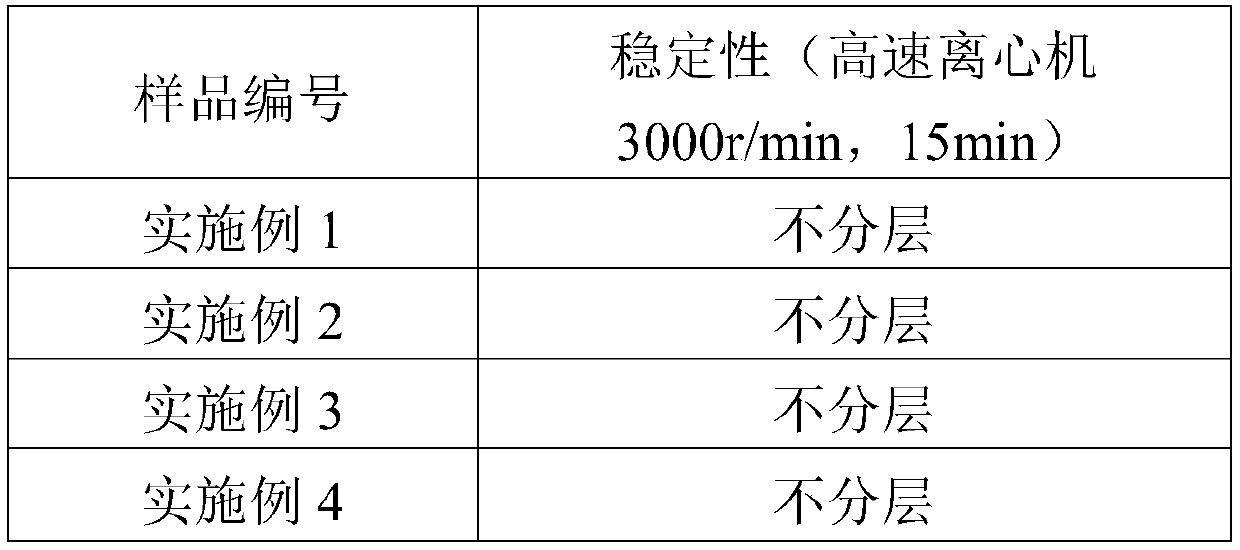Reactive emulsifier, water-borne epoxy resin emulsion, preparation and application
A reactive emulsifier, water-based epoxy resin technology, applied in the direction of online phenolic epoxy resin adhesive, epoxy resin glue, epoxy resin coating, etc., can solve the problem of reducing the mechanical properties of coatings, adhesion performance, water resistance and waterproofing Corrosion performance, easy water absorption and whitening of the coating film, complicated preparation methods, etc., to achieve the effects of low production cost, good stability, and simple process flow
- Summary
- Abstract
- Description
- Claims
- Application Information
AI Technical Summary
Problems solved by technology
Method used
Image
Examples
Embodiment 1
[0046] (1) Add 30g of cardanol (0.1mol) and 10g of diethylenetriamine (0.1mol) into a three-necked flask with a mechanical stirring paddle and a condenser, heat the constant temperature oil bath to 50°C, and mix the reactants Slowly add 3g of paraformaldehyde (based on the amount of formaldehyde, the dosage is 0.1mol) in batches, and react for 1h after the addition; then raise the temperature to 90°C, and continue the reaction for 3h under the condition of an oil bath; after the reaction is completed, the reaction system is cooled to 50 ℃ to stop the reaction to obtain the intermediate product phenalkamine;
[0047] (2) Slowly add 37.5g polyethylene glycol diglycidyl ether (epoxy value 0.32, consumption 0.06mol) in batches to the intermediate product phenalkamine obtained in step (1), after the addition is complete, react at 50°C for 2h, Obtain 80.5g reactive emulsifier;
[0048] (3) Slowly add water to the reactive emulsifier prepared in step (2) (the amount is 4 times the m...
Embodiment 2
[0052] (1) Add 30g of cardanol (0.1mol) and 16g of triethylenetetramine (0.11mol) into a three-necked flask with a mechanical stirring paddle and a condenser, heat the constant temperature oil bath to 55°C, and mix the reactants Slowly add 3.3g of paraformaldehyde (0.11mol based on the amount of formaldehyde) in batches, and react for 0.5h after the addition; then raise the temperature to 95°C, and continue the reaction for 4h under the condition of an oil bath; after the reaction is completed, the reaction system is cooled Stop the reaction at 55°C to obtain the intermediate product phenalkamine;
[0053] (2) Slowly add 33.5g polyethylene glycol diglycidyl ether (epoxy value 0.3, consumption 0.05mol) in batches to the intermediate product phenalkamine obtained in step (1), after the addition is complete, react at 55°C for 3h, Obtain 82.8g reactive emulsifier;
[0054] (3) Slowly add water to the reactive emulsifier prepared in step (2) (the amount is 6 times the mass of the ...
Embodiment 3
[0058] (1) Add 30g of cardanol (0.1mol) and 27.6g of polyetheramine D-230 (0.12mol) into a three-necked flask equipped with a mechanical stirring paddle and a condenser, and heat the constant temperature oil bath to 60°C. Slowly add 3g of paraformaldehyde in batches to the mixed reactant (based on the amount of formaldehyde, the dosage is 0.1mol), and react for 0.5h after the addition is complete; then raise the temperature to 100°C, and continue the reaction for 3.5h under the condition of an oil bath; after the reaction is completed, put The reaction system was cooled to 60°C to stop the reaction, and the intermediate product phenalkamine was obtained;
[0059] (2) Slowly add 25g of polyethylene glycol diglycidyl ether (epoxy value 0.4, dosage 0.05mol) in batches to the intermediate product phenalkamine obtained in step (1), after the addition is complete, react at 60°C for 4h to obtain 85.6g reactive emulsifier;
[0060] (3) Slowly add water to the reactive emulsifier prep...
PUM
 Login to View More
Login to View More Abstract
Description
Claims
Application Information
 Login to View More
Login to View More - R&D
- Intellectual Property
- Life Sciences
- Materials
- Tech Scout
- Unparalleled Data Quality
- Higher Quality Content
- 60% Fewer Hallucinations
Browse by: Latest US Patents, China's latest patents, Technical Efficacy Thesaurus, Application Domain, Technology Topic, Popular Technical Reports.
© 2025 PatSnap. All rights reserved.Legal|Privacy policy|Modern Slavery Act Transparency Statement|Sitemap|About US| Contact US: help@patsnap.com



